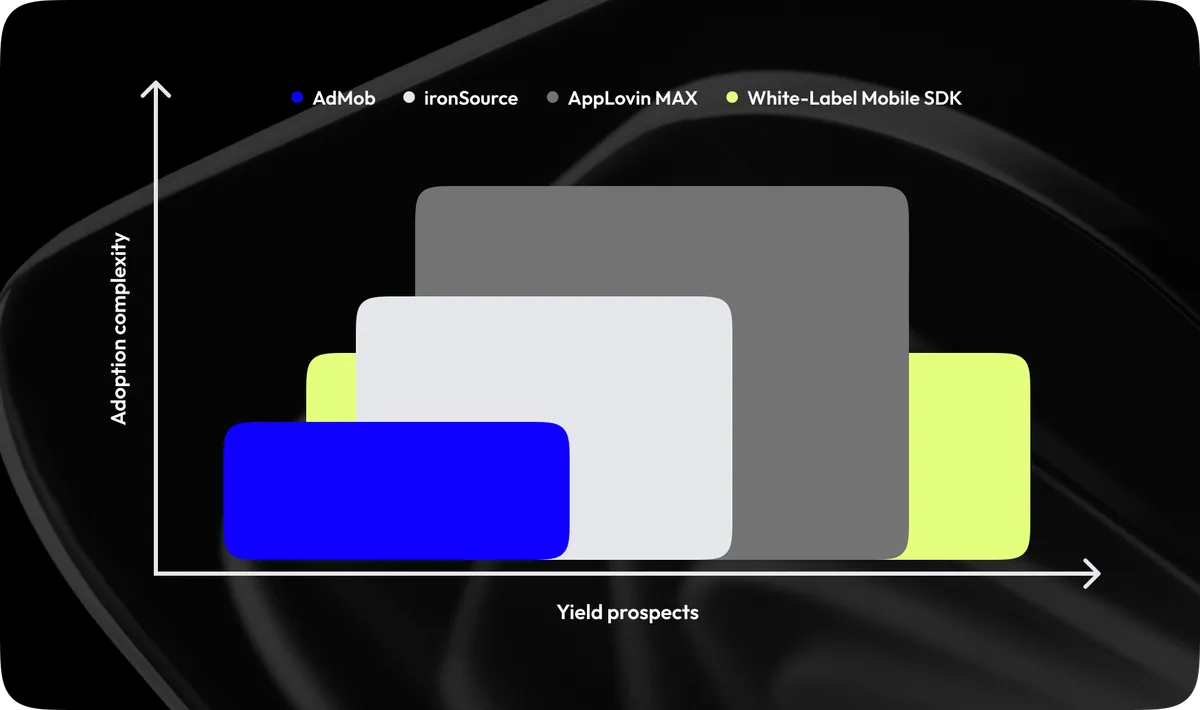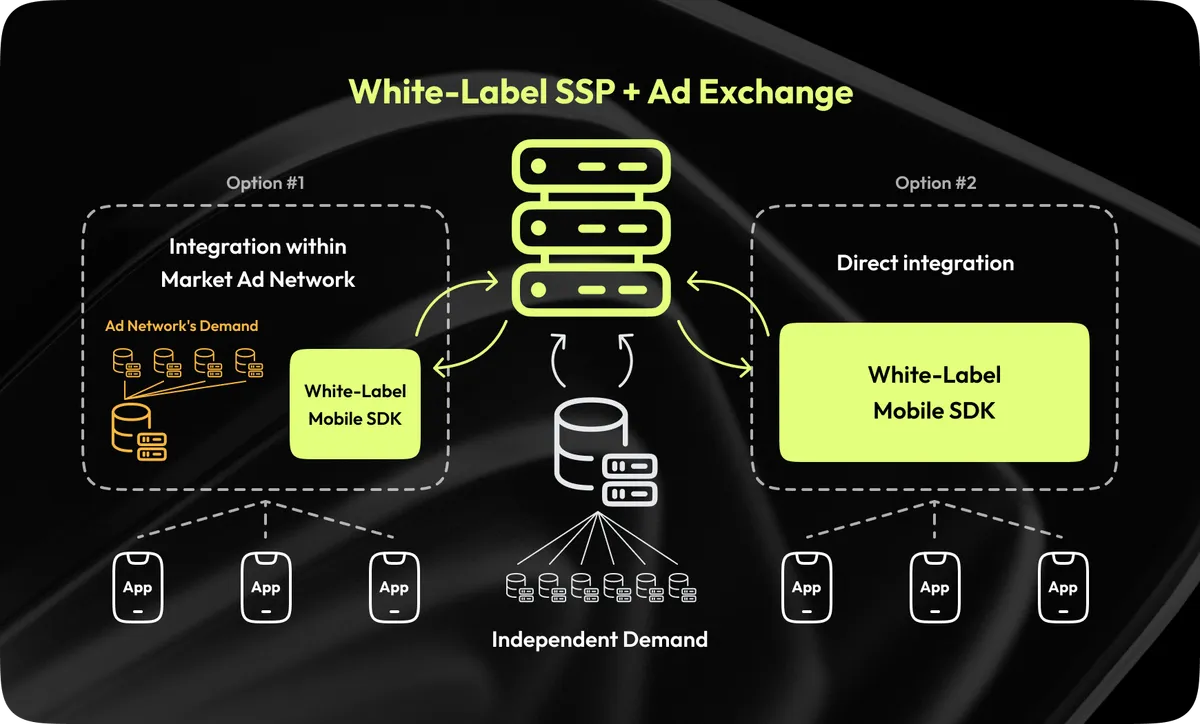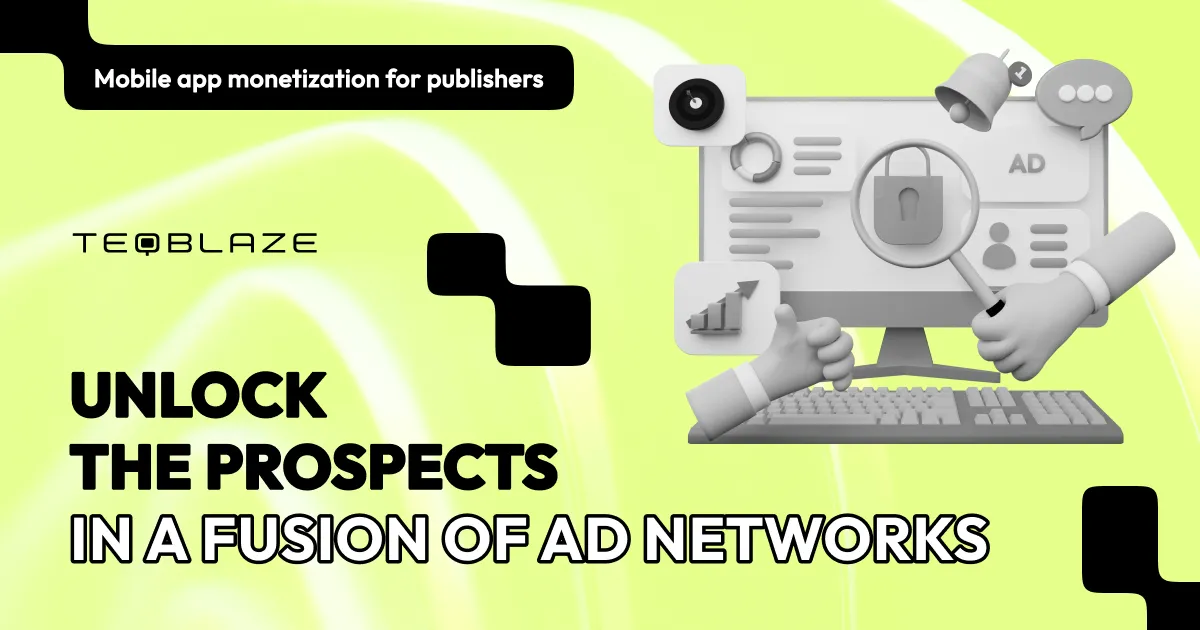This article will disclose the basic differences in mobile game monetization with ads within three popular ad networks: AdMob, ironSource, and AppLovin MAX. The TeqBlaze team suggests these networks as the most widely used and able to cover the needs of publishers with diverse app portfolio dimensions.
The red thread running through the article is the approach to understanding SDK and gaining advanced possibilities in monetizing apps using white-label mobile SDK. It has been designed to provide additional value in a fusion of ad networks.
Where to start?
Before knowing how to monetize an app, its owner should integrate a software development kit (SDK) provided by the ad network chosen into the application code. This is the most challenging part of the business. Let’s follow the line.
SDK deployment requires developers' time
After the work is done, you will have to update the application, which users never like
To avoid difficulties, it is recommended to test different usage scenarios after adding the SDK for monetization
That’s why it is essential to meticulously study the differences between the advantages and disadvantages that different ad networks provide. So, let’s continue our ad tech immersion.
How to scale monetization opportunities?

The graph represents the scale of yield prospects and adoption complexity of the overviewed ad networks and an advanced monetization approach
Each ad network provides several demand sources by default for supplying apps with ads. However, these sources are usually limited by prices and topics, so some ad spots in apps may not be used, resulting in lost profit for the publishers. And these words hurt as deeply as a blade.
With the scaling of the advertising portfolio and the desire to increase user acquisition, publishers come up with two simple solutions.
Enable ad mediation based on the chosen network to connect third-party demand-side sources.
Provide support for multiple ad networks simultaneously by deploying additional SDKs in applications.
Usually, things develop in this order. Larger publishers can adopt both approaches simultaneously. Each has its advantages and disadvantages, but globally, as follows: as long as the publisher remains within the networks’ advertising sources, control over monetization will remain fragmented.
To enhance monetization opportunities, publishers need to:
Control the ad margin
Connect their own unique demand sources
Use data that app users have shared with consent for retargeting and building databases
Utilize automated optimization techniques based on models with machine-learning features
All of this and more is impossible if you stay within the infrastructure of ad networks. That's why TeqBlaze engineers have developed a white-label mobile SDK that works inside the global programmatic advertising landscape using the white-label SSP+ Ad Exchange platform.
We call this path independent navigation because once you have obtained the opportunity to work with your advertisers and control the financial side of the issue, you are free to manage every aspect of monetization within your own development strategy. This way is not for everyone, but it exists, and we are glad to tell you about it. Stepping into programmatic is the way to develop applications by expanding audience reach on a global scale.
Google AdMob: entry point for mobile publishers
Publishers starting to monetize mobile apps with ads will likely choose AdMob because it is simple, effective, and user-friendly. Google will undoubtedly take its chance to improve our lives, but some pitfalls are worth mentioning.
We’d also like to emphasize that AdMob is an integral part of a global approach to diversifying monetization tools. However, each path has a continuation.
Advantages of AdMob
Google infrastructure’s benefits. AdMob is one of Google's products, so it is perfectly adapted for interaction between different services, providing users with reliable and familiar application monetization opportunities. For instance, all analytics on advertising campaigns are available in Google Analytics, which significantly simplifies the evaluation and control over mobile assets.
The highest level of ethicality and security. Publishers do not risk compromising their applications with questionable content, as we discuss Google’s high business standards. With AdMob, the issue of ad fraud is unlikely to bother you during monetization.
Effortless implementation and competitive CPMs. Thanks to the user-friendly interface, the speed of payments, and the trouble-free technical part of the product, AdMob is ideal for perfecting the skills of app monetization. You can use insights gained from campaign analytics to improve performance in real-time and choose competitive CPMs (which nevertheless strongly depend on user geography) that will satisfy you for a long span.
Excellent fill rate. Thanks to Google’s rich demand, publishers can be sure that their ad space will be filled by more than ninety percent most of the time. Total occupancy is also possible, as the ad network has all the necessary resources.
Disadvantages of AdMob
Challenges with blocking ad accounts. Unfortunately, Google's high standards have a downside: even insignificant violations of advertising rules can lead to a lengthy account ban. Thus, publishers lose revenue due to the simultaneous disabling of monetization in all applications connected to the same account.
Limited opportunities for advertising mediation. AdMob does provide the infrastructure for connecting high-level third-party ad sources. Still, the terms of these services are less attractive than those of specialized ad mediation companies. In addition, setting up extra advertising sources requires the participation of experts who must keep the settings balanced to reach the desired results.
High fees and fragmented support. No doubt, Google’s ads are effective in their field. However, as gross revenues increase, so does the commission charged for AdMob services. Also, users regularly complain about the inability to discover the details of blocking or suspending specific campaigns. It’s also taking time to get assistance from AdMob specialists when things start going wrong.
ironSource: a great alternative to Google with admirable ad mediation opportunities
In the language of monetization experts, ironSource is a richer tool that offers many more creativity opportunities than AdMob. However, be prepared that these possibilities require closer attention from the engineers when implemented into apps and additional time to calibrate to reach the desired profits.
IronSource features are more popular among mobile game developers in terms of monetization than among casual application developers.
The experience of TeqBlaze experts shows that publishers often use ironSource features in combination with AdMob. This approach makes sense if your development team is able to predict and eliminate conflicts between different SDKs and customize traffic shaping on their own. Among other benefits, white-label mobile SDK solves these challenges as well.
Advantages of ironSource
Extensive analytical capabilities for measuring campaigns. The performance analysis features of ironSource will show you a detailed picture of how app users interact with the app and the ad blocks inside it. This is relatively closed data available within the ad network, unlike AdMob. Still, these insights will be helpful to you.
Comprehensive ad mediation. Within Unity LevelPlay, you can set up mediation with third-party demand sources. Thanks to the management tools inside the ecosystem, publishers can differentiate between user groups and conveniently analyze the results of attracting additional traffic.
Strong customer support. IronSource functionality is complex and broad enough to get confused more than once. Nevertheless, the ad network support team works so well that users unanimously call this partnership facet its strength.
Advanced features for perfecting the ad experience. A/B testing, creative management, and automatic optimization are designed to improve your apps' monetization results. This functionality is not exhaustive, but its positive contribution is significant.
Disadvantages of ironSource
Complex setup and calibration, long learning time. This can't be called a whole drawback, as it always depends on the platform: the more features it has, the harder it is to master.
Poor opportunities for monetizing traffic from certain countries. For instance, users often complain that monetizing traffic from South America with ironSource could be more effective. The same applies to other regions outside Europe, the USA, and Canada. Before you start using the ad network, TeqBlaze experts advise you to study the current performance of traffic monetization with ironSource in your region.
A significant percentage of fraudulent traffic. The advertising network has its own algorithms for identifying and blocking such traffic, which are constantly improving. But obviously, more is needed. The issue of fraudulent traffic in ironSource monetization is among the platform’s top most widespread difficulties.
Limited opportunities for original demand. Users emphasize the broad potential of ironSource as a mediation platform and the relatively low capabilities of the platform’s own demand. This is most often expressed in low fill rates and profitability.
AppLovin MAX: your field to work growing in-app monetization
Consider things on your own: 25 networks, 20 bidders, 100 DSPs — all eager to buy your in-app advertising inventory. AppLovin MAX allows you to hold unified auctions among them to achieve higher profits, following the real-time bidding (RTB) principle. However, it would help if you remembered that AppLovin MAX services cost way more than the rewards of the programmatic ad platforms in OpenRTB auctions.
It’s also notable that AppLovin premium demand is games-oriented, making it less effective in promoting business applications. The network’s approach to charging is also unified for all types of applications.
Advantages of AppLovin MAX
User-friendly platform. Despite the many features and the ability to request additional integrations directly from the ad network development team, AppLovin MAX remains user-friendly, with straightforward navigation and a quick entry threshold.
Well-built assistance management. AppLovin MAX offers many ad formats, and the support team will help you set up each. The ad network’s team is interested in long-term partnerships and actively invests in developing publishers’ experiences.
Extensive traffic for various campaigns. CPM, CPA, CPP/CPO (and CPE/CPR). There are too many abbreviations for beginners, but they are enough to launch various advertising campaigns in precisely divided user segments. AppLovin MAX gives publishers complete freedom of action in this regard.
Good analytics. It is as accurate as that of the previous ad network, ironSource, but less integrative than AdMob offers. Discrepancies in calculating campaign performance and financial estimates either do not occur or occur with minimal error when numerous ad sources are simultaneously involved.
Convenient waterfall and bidding setup. AppLovin MAX customers can use two types of interactions with demand sources, conveniently switching between them to discover the most profitable option for various settings. The TeqBlaze team, however, advises developing chiefly bidding opportunities.
Disadvantages of AppLovin MAX
Integration challenges and complexity of management. Similar to ironSource, integrating AppLovin MAX requires technical expertise. Also, extensive monetization options will need more time to study, set up, and control. At the same time, you can always start using the basic functions and then master more advanced approaches as you learn. However, TeqBlaze experts emphasize that you should choose AppLovin MAX if you have at least minimal experience monetizing apps utilizing other ad networks.
Unclear revenue share model. This is the fundamental weakness of all ad networks: they can never provide transparent terms and conditions for charging fees for their services. The more mediation sources are connected, the more vague the exact share that the platform keeps in the overall profitability.
Imbalanced traffic diversity across advertising formats. Of course, the platform supports many ad formats, but if you want to use high-impact ones, be prepared that the volume of this traffic type is limited. In other words, the fill rate for banners and rewarded ads will differ.
Final comparison
AdMob | ironSource | AppLovin MAX | White-label mobile SDK | |
Connected ad sources by default | Google demand: Google Ads, Display & Video 360 | ironSource demand | AppLovin demand | Any demand sources connected to the white-label SSP+ Ad Exchange platform |
Ad mediation | Yes, at least 25 third-party demand sources are available | Yes, at least 25 third-party demand sources are available within Unity LevelPlay Mediation | Yes, at least 26 third-party demand sources are available | Yes, it supports unlimited ad mediation with any of the listed networks and third-party sources |
Custom adapters to obtain exclusive ad traffic | Yes | No adapters are required to connect exclusive demand sources | ||
Ad formats | Native, rewarded, banner, video, and interstitial ads | Rewarded, playable, interstitials, and banners/MREC | Native, interstitial, rewarded, playable, rich media, MREC, banner, display | Banner HTML + MRAID 3 ads, outstream video, interstitial (HTML/Video), native, Google IMA SDK in-stream video |
Advanced features | Level revenue and campaign data in Google Analytics, blocking and filtering controls for ads | Analytics, creative management, A/B testing, automated campaign optimizers | Advanced reporting, A/B testing, automated campaign optimization by CPM | Performance dashboards, event tracking, first-party data collection, network management for traffic shaping (choose the highest CPMs), unlimitedly scalable and fully customizable infrastructure |
Type of connection | Direct via SDK | Direct via SDK or within compared networks | ||
Fees | Up to 40% | Control the margin on your own | ||
Choosing the right ad network for your mobile app maximizes revenue and ensures a positive user experience. Each offer has unique strengths and a set of challenges. Understanding these pros and cons will help you make an informed decision and unlock the full potential of your app monetization strategy.
Cross the boundaries to grow beyond
Publishers will sophisticate their technology portfolio in one way or another to achieve state-of-the-art brand safety and obtain advanced monetization opportunities. The TeqBlaze team offers a ready-made solution to scale advertising revenue and app monetization, solving the general challenge of growing your business.
The white-label mobile SDK lets you connect independent demand sources and control the margin when launching campaigns.
You do not need to change or modify your settings if you already use one of the ad networks mentioned. We will help you enrich your advertising infrastructure, fully preserving the progress you have made with the ad network’s demand.

Options for monetizing apps by connecting independent traffic sources
White-label mobile SDK is an all-in-one ad monetization solution to engage and retain customers. It expands app monetization infrastructure to possess scalable programmatic trading. With no limits for perfecting business results. Talk to an expert to discuss partnership opportunities.

 Grigoriy Misilyuk
Grigoriy Misilyuk





